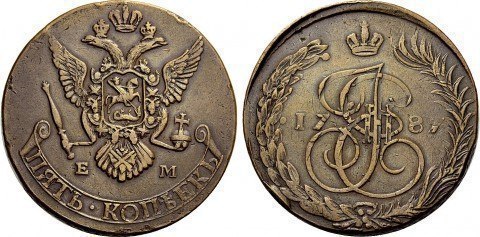The Swedish nickel and what does Gustav the Third have to do with it? Note to the digger.
How nice it is sometimes to dig up five kopecks from the times of Catherine the Second (the Great), really? A large coin that sounds pleasant and loud on any device, and you can pick it up from great and incredible depths. Yes, I love sweet finds! But how much such a find can cost if you look closely at it ? Some $5-$10, and others even more than $1500. So what’s the difference?
Here she is — the heroine of our story:

They look like ordinary five kopecks, but if you look closely, you will find some differences. For example:
— Dates 1764, 1778, 1787 (1787 sometimes does not have a mint designation)
— All nickels depict the Royal Crown (five petals joined together), and not the Imperial Crown (two separated hemispheres) as it should be.
— The eagle was copied from the 1768-1778 nickels (narrow wings) regardless of the date on the coin.
— Numeral 1 in fake Roman nickels I.
How did this happen?
There once lived a Swedish king, Gustav III. And he wanted to take revenge on the Russian Empire for the defeats suffered by Sweden. Having bided his time, in the midst of the Russian-Turkish War, Gustav III treacherously attacked Russia in 1788. But the war required money, and the greedy king did not have money, so he decided to resort to cunning. He ordered the minting of Russian coins to begin in order to pay with them to his troops, who could already pay the local Russian population with the received coins. The minting of counterfeit coins was commissioned in 1788 to the mint in Avesta, a small town in central Sweden. The Swedes, preparing for the mass minting of «Russian» nickels, prepared a large number of coin stamps and began to issue coins with the dates of the three previous years, 1764, 1778, and 1787, in order to make it difficult to detect counterfeit coins.

However, Gustav III’s cunning and insidious plan failed, the war was lost thanks to the heroic resistance of the Russian Imperial Army, and it was decided to confiscate and destroy the created coins in order to keep the whole action secret.
How do we explain the differences in the designs on the coins? It’s very simple: Swedish coin masters simply did not know that in Yekaterinburg already in 1780 they completely switched to minting modified coins with a new type of eagle.
This coin is considered quite rare, according to V.V. In total, approximately 2,700 coins were minted by Uzdenikov, but they appeared at auctions only twice, so the price for this coin can be quite high due to its rarity.
Seek and ye shall find! I collect more informative here.
